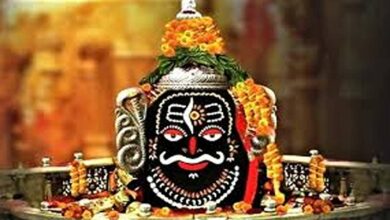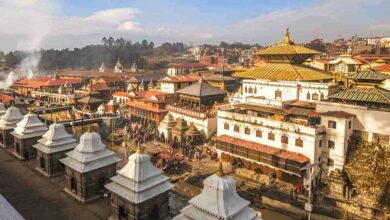Ghusmeshwarnath Temple: Know about the history and importance of Ghushmeshwarnath temple located in Maharashtra
Ghusmeshwarnath Temple: One of the holiest Hindu temples in the Indian state of Maharashtra is Ghushmeshwarnath Temple, also called Grushneshwar Jyotirlinga Temple. Dedicated to Lord Shiva, this temple is regarded as one of the twelve Jyotirlingas, or divine manifestations of Lord Shiva. To seek Lord Shiva’s blessings, devotees go from all across the nation and even beyond to this temple. You should read this article through to the conclusion since it will provide you comprehensive information about the Ghushmeshwar Nath Temple, including its history, architecture, and significance.

Ghushmeshwarnath Temple’s History
Sudharma was an extremely intelligent Brahmin who resided close to the Devgiri mountain in South India. Sudeha was the name of his wife. They were deeply in love with one another. They didn’t have any kids. According to astrological calculations, Sudha was unable to conceive. She still desired a kid, however. After that, Sudha instructed her husband, Sudharma, to wed her younger sister. At first, Sudharma refused to accept this, but when Sudha persisted, Sudharma bowed.
Ghushma, the younger sister of his bride, was taken home by Sudharma after they were married. Ghushma was a very modest and moral lady. She also had a strong devotion to Lord Shiva. Every day, Ghushma would create 101 Shivlingas and adore them fervently. Because of Lord Shiva’s blessing, a kid eventually was born at her home. The two sisters were ecstatic. They were both very much in love and living together. However, Sudha had an incorrect idea. She believed that nothing in this home belonged to me and that everything belonged to Ghushma.
Sudha gave this a lot of attention and it became ingrained in her memory. Sudha believed that Ghushma had also claimed her husband and that the kid was hers. The kid of Ghushma had grown up and gotten married. One day, as Ghushma’s little boy was resting at night, she murdered him because of all these negative thoughts. She tossed his corpse into the pond there. Every day, Ghushma would toss clay Shivlingas into this same pond.
The whole home was in disarray when dawn arrived. Ghushma began sobbing severely, as did her daughter-in-law. Ghushma, however, continued to believe in Shiva. Like every day, she also worshiped Shiva on this day. When she walked to the pond to toss the clay Shivlings after the puja was over, her kid was seen emerging from it. He emerged and began his customary caressing of Ghushma’s feet. It seemed as if her kid had just returned from a trip.
Lord Shiva eventually made an appearance there as well. Shivaji was furious with Sudha and planned to use his trident to murder her, so he requested Ghushma to seek a boon. However, with her palms clasped, Ghushma begged Lord Shiva to pardon her sister. Ghushma also requested that Lord Shiva remain here as a favor. Shiva pardoned Sudha and received both of Ghushma’s goods. In addition, he became permanently settled there as a Jyotirlinga.
Ghushmeshwarnath Temple’s Significance
One of the 12 Jyotirlingas, which are regarded as Lord Shiva’s holiest sanctuaries, is the Ghushmeshwarnath Jyotirlinga temple, a very significant and venerated location in Hindu mythology. The following are some of the Ghushmeshwar Jyotirlinga temple’s main significance:
- Spiritual Significance: This temple is regarded as one of Lord Shiva’s most potent manifestations. It is stated that those who worship this temple fervently and virtuously are blessed, safe, and saved.
- Historical Significance: Vajranabha, Lord Krishna’s grandson, is mentioned in the temple’s lengthy and rich history. The temple complex is said to have grown throughout time under the influence of several kings and followers, making it a significant location with architectural and cultural value.
- Cultural Significance: The temple is a popular destination for Lord Shiva worshipers and draws many tourists during significant holidays like Maha Shivaratri and Shravan. The temple is regarded as a significant component of India’s cultural legacy and represents the dynamic and timeless Hindu civilization.
- Architectural Significance: With elaborate carvings and sculptures on the walls and ceilings, the temple’s architecture is a superb illustration of traditional Hindu temple design. The temple’s enormous pond, little shrines, and magnificent entryway all contribute to the building’s majesty.
When to go to the temple of Ghushmeshwarnath
The Ghushmeshwarnath Temple is open from 5:30 am to 9:30 pm. The temple is open from 3:00 am to 11:00 pm throughout the month of Shravan. During this period, the temple also conducts a number of rites. These ceremonies, such as the afternoon and evening aartis, might include devotees.
How can I go to the temple of Ghushmeshwarnath?
By Air: Regular flights are available to Jaipur, Mumbai, Udaipur, and Delhi from Aurangabad Airport, the closest airport, which is located 29 kilometers from Grishneshwar. You may always attempt connecting flights to Grishneshwar if you are traveling from another city.
By Train: Aurangabad, which lies off the main road, has the closest train station. Manmad, 140 kilometers away, is the closest major train station. There are two train stations close to Grishneshwar: Manmad Junction (MMR), which is 86 km away, and Aurangabad (AWB), which is 22 km away.
In brief
Thousands of devotees visit Lord Shiva each year at the Ghushmeshwarnath Temple, a popular pilgrimage destination. The Ghushmeshwarnath Temple is a significant location both spiritually and historically. This temple is a representation of Maharashtra’s diverse customs and culture. We have given you comprehensive information on the Ghushmeshwar Nath Temple in today’s post; if you like it, please read it and tell your friends about it.
FAQs
Q. To which god is the Ghushmeshwarnath Temple dedicated?
A. Lord Shiva, also referred to as Ghushmeshwarnath here, is the object of devotion in this temple.
Q. What time of year is ideal for visiting Ghushmeshwarnath Temple?
A. The months of October through March provide the greatest weather for a visit to Ghushmeshwarnath Temple.
Q. What role does Ghushmeshwarnath Temple play in tourism?
A. A well-liked tourist site is this temple. Tourists are drawn to this location by its religious importance and natural beauty.
Q. What role does the Ghusmeshwarnath Temple play in religion?
A. For Hindus, this temple is a significant place of pilgrimage. To visit Lord Shiva, devotees go from all over the world.
Q. Which holidays are observed in the Temple of Ghusmeshwarnath?
A. This temple celebrates holidays like Mahashivratri, Monday, Pradosh, and Nagpanchami with tremendous fanfare.





